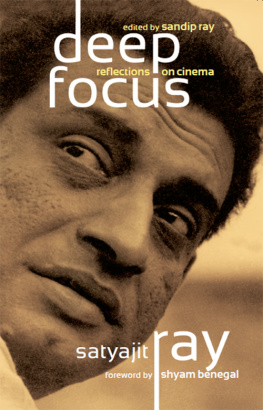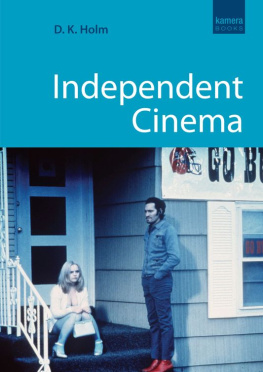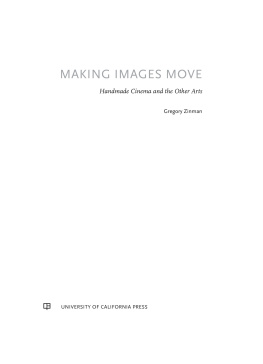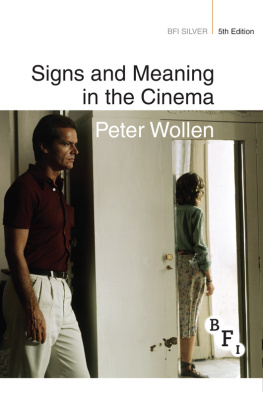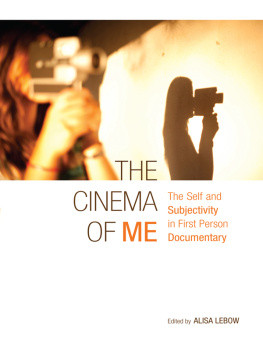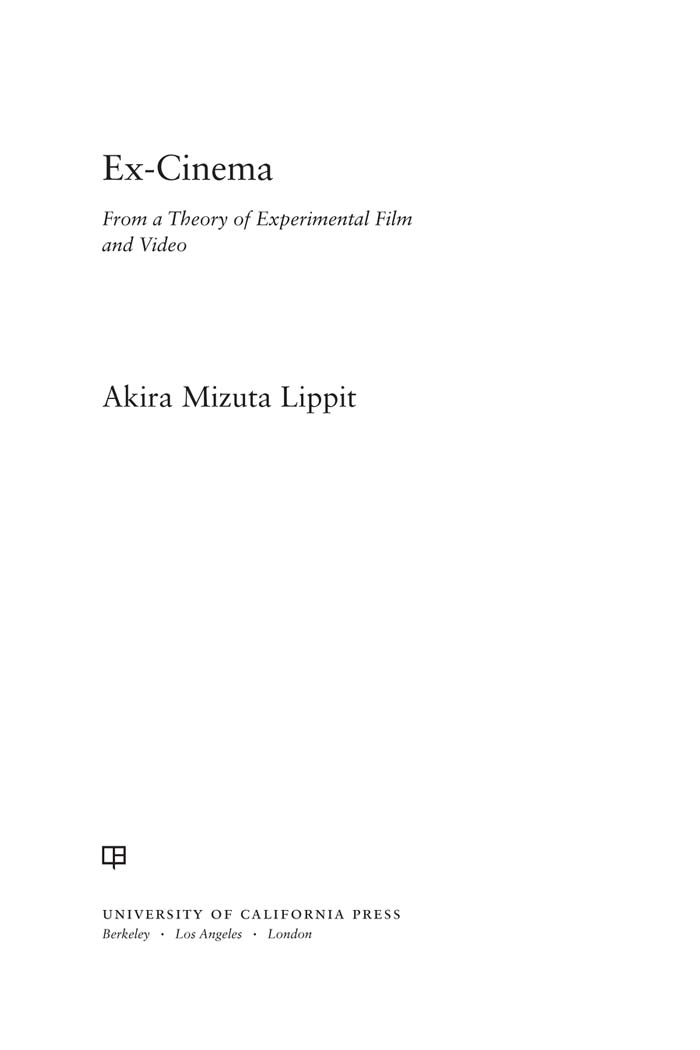Ex-Cinema
Ex-Cinema
From a Theory of Experimental Film and Video
Akira Mizuta Lippit

University of California Press, one of the most distinguished university presses in the United States, enriches lives around the world by advancing scholarship in the humanities, social sciences, and natural sciences. Its activities are supported by the UC Press Foundation and by philanthropic contributions from individuals and institutions. For more information, visit www.ucpress.edu.
University of California Press
Berkeley and Los Angeles, California
University of California Press, Ltd.
London, England
2012 by The Regents of the University of California
Library of Congress Cataloging-in-Publication Data
Lippit, Akira Mizuta.
Ex-cinema : from a theory of experimental film and video / Akira Mizuta Lippit.
p. cm.
Includes index.
ISBN 978-0-520-27412-9 (hardcover : alk. paper)
ISBN 978-0-520-27414-3 (pbk. : alk. paper)
1. Experimental filmsHistory and criticism.
I. Title.
PN1995.9.E96L57 2012
791.43611dc23
2012010874
Manufactured in the United States of America
21 20 19 18 17 16 15 14 13 12
10 9 8 7 6 5 4 3 2 1
The paper used in this publication meets the minimum requirements of ANSI/NISO z39.48-1992 ( R 2002) (Permanence of Paper).
Contents
Illustrations
Acknowledgments
Many of the filmmakers and artists discussed in this book have engaged this work, offering insights, responses, and criticisms of my writing at various stages. I am especially grateful to Martin Arnold, Su Friedrich, Matthias Mller, Walid Raad, Jay Rosenblatt, Phil Solomon, Diana Thater, Peter Tscherkassky, Naomi Uman, and Caveh Zahedi, who have served as interlocutors from the books conception and throughout its production. The time and energy that each contributed was truly a gift, and their work remains the reason for this book. I wish to thank my colleagues and students at the University of Southern California in the School of Cinematic Arts and the Departments of Comparative Literature and East Asian Languages and Cultures, who have provided so much support and inspiration. My sincerest gratitude to Dean Elizabeth M. Daley of the School of Cinematic Arts, who has supported me unequivocally since the time I arrived. The members of the Visual Studies group at USC, especially Richard Meyer and Vanessa Schwartz, have continuously energized and reenergized this project, and Kate Flint, Janet Hoskins, Kara Keeling, Nancy Lutkehaus, and Alexander Marr offered generous responses to an earlier iteration of Out of the Blue, as did Jennifer Barker, Alessandra Raengo, and Angelo Restivo at Georgia State University; and members of the Film Studies Program, notably Dudley Andrew and Patrick Reagan, at Yale University. David E. James and Michael Renov forged the way for this book; their mentorship has been crucial in shaping my own attempts to think through the avant-garde.
Jean-Claude Lebensztejn is the origin of more in this book than I acknowledge, and I am grateful for his singular and enduring friendship. I cannot begin to enumerate my debt to Vivian Sobchack, intellectually and professionally, but anyone who knows her will understand this. Three anonymous readers provided vigorous criticism of this manuscript at earlier stages; I hope they will see their efforts reflected in this book. Along the way, I benefited from many responses to different portions of the book. I wish to thank Steve Anker, the late Paul Arthur, James Leo Cahill, Elizabeth Cowie, Safaa Fathy, Roy Grundmann, Peggy Kamuf, Dragan Kujundzic, David Lloyd, Randy Malamud, Laura U. Marks, Sally Ness, Carrie Noland, Scott Nygren, Donald Pease, Brnice Reynaud, John Carlos Rowe, Louis-Georges Schwartz, Shelley Stamp, Lesley Stern, Maureen Turim, and Genevieve Yue for their contributions. Mary Francis at the University of California Press committed to this project from the start, and I am grateful for her unwavering support, critical insight, and skillful efforts to bring this into existence. UC Press Editorial Coordinator Kim Hogeland has been remarkable at every stage of production, and I had a great experience working with Production Editor Brian Ostrander and the team at Westchester Publishing Services. This book comes from my family: my love and gratitude to Miya, Kohryu, Raizoh, and Reiun, and a long overdue expression of gratitude to my mother and father.
Earlier versions of several chapters appeared in the journals Afterimage and Discourse, and in books published by Columbia University Press, the Dia Foundation, and the University of Minnesota Press. Although those essays have been reworked extensively, I am grateful to these organizations for allowing me to publish the revised versions:
Cinemnesis: Martin Arnolds Memory Apparatus is a revised version of Cinemnesis: Martin Arnolds Memory Machine, which appeared in Afterimage 24.6 (May/June 1997): 810.
Derrida, Specters, Self-Reflection is a revised version of Reflections on Spectral Life, which appeared in Discourse: Journal for Theoretical Studies in Media and Culture 30, no. 12 (2008). Copyright 2009 Wayne State University Press. Used with permission by Wayne State University Press.
Parenthesis: Video Ergo Sum is a revised version of Video Ergo Sum (The Animal That I See), in Diana Thater: Knots and Surfaces, ed. Lynne Cooke and Karen Kelly (New York: Dia Center for the Arts, 2002).
Digesture: Gestures without Bodies is a revised version of Digesture: Gesture and Inscription in Experimental Cinema, in Migrations of Gesture, ed. Carrie Noland and Sally Ann Ness (Minneapolis: University of Minnesota Press, 2008), 11331. Reprinted by permission of the University of Minnesota Press.
Revisionary Cinema is a revised version of The Only Other Apparatus of Film (A Few Fantasies about Diffrance, Dmontage, and Revision in Experimental Film and Video), in Derrida, Deleuze, Psychoanalysis, ed. Gabriele Schwab (New York: Columbia University Press, 2007). Copyright 2007 Columbia University Press. Reprinted with permission of the publisher.
EXC00
Exergue Ex-Cinema
An exergue, from the Greek ex (outside) and ergon (work), refers to a space outside the work, outside the essential body of the work, and yet part of it, even essentiallya part and apart. An exergue locates an outside space that is included in the work as its outside. What kind of work, and what kind of outside? The Oxford English Dictionary defines the exergue as a small space usually on the reverse side of a coin or medal, below the principal device, for any minor inscription, the date, engravers initials, etc. Also, the inscription there inserted. A small space for minor inscriptions as well as the inscription itself. Inscription and the space of inscription (they appear to bear the same significance in an exergue) located on the body of a work or object (ergon), but on the other side, away. But not far away from the work, neither within nor without it, a minor space of inscription and a minor inscription. In a literary or artistic work, a place that forms an interstice between the frame or framework, parergon, and the proper body of the work, ergon. It belongs neither to the inside nor the outside, is proper to neither, but also exists before and beyond the work, a work that comes apart, exergue.


